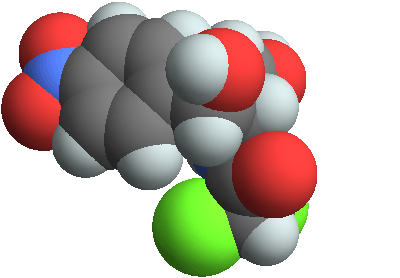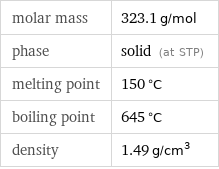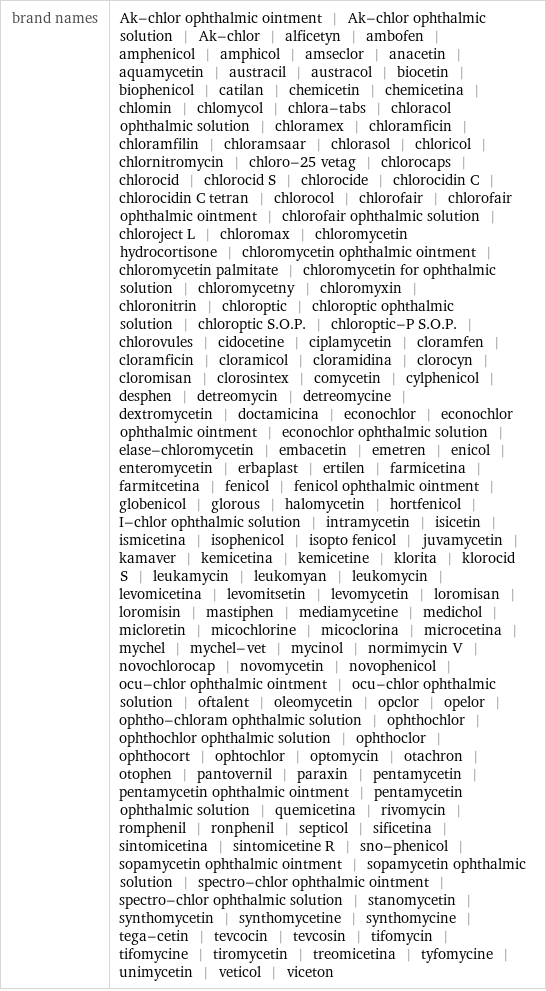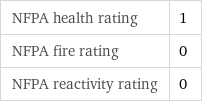Input interpretation

chloramphenicol
Chemical names and formulas
![formula | C_11H_12Cl_2N_2O_5 name | chloramphenicol IUPAC name | 2, 2-dichloro-N-[(1R, 2S)-1, 3-dihydroxy-1-(4-nitrophenyl)propan-2-yl]acetamide alternate names | amphenicol | amseclor | chlomycol | chloramsaar mass fractions | C (carbon) 40.9% | Cl (chlorine) 21.9% | H (hydrogen) 3.74% | N (nitrogen) 8.67% | O (oxygen) 24.8%](../image_source/78a8b3d482881d2c632e9a1a40e47761.png)
formula | C_11H_12Cl_2N_2O_5 name | chloramphenicol IUPAC name | 2, 2-dichloro-N-[(1R, 2S)-1, 3-dihydroxy-1-(4-nitrophenyl)propan-2-yl]acetamide alternate names | amphenicol | amseclor | chlomycol | chloramsaar mass fractions | C (carbon) 40.9% | Cl (chlorine) 21.9% | H (hydrogen) 3.74% | N (nitrogen) 8.67% | O (oxygen) 24.8%
Lewis structure

Draw the Lewis structure of chloramphenicol. Start by drawing the overall structure of the molecule, ignoring potential double and triple bonds: Count the total valence electrons of the carbon (n_C, val = 4), chlorine (n_Cl, val = 7), hydrogen (n_H, val = 1), nitrogen (n_N, val = 5), and oxygen (n_O, val = 6) atoms: 11 n_C, val + 2 n_Cl, val + 12 n_H, val + 2 n_N, val + 5 n_O, val = 110 Calculate the number of electrons needed to completely fill the valence shells for carbon (n_C, full = 8), chlorine (n_Cl, full = 8), hydrogen (n_H, full = 2), nitrogen (n_N, full = 8), and oxygen (n_O, full = 8): 11 n_C, full + 2 n_Cl, full + 12 n_H, full + 2 n_N, full + 5 n_O, full = 184 Subtracting these two numbers shows that 184 - 110 = 74 bonding electrons are needed. Each bond has two electrons, so in addition to the 32 bonds already present in the diagram add 5 bonds. To minimize formal charge oxygen wants 2 bonds and carbon wants 4 bonds. Identify the atoms that want additional bonds and the number of electrons remaining on each atom: To fully fill its valence shell, nitrogen will donate one of its electrons, allowing it to form four bonds (the maximum number an element on period 2 can form). Fill in the 5 bonds by pairing electrons between adjacent highlighted atoms, noting the formal charges of the atoms. Double bonding nitrogen to the other highlighted oxygen atom would result in an equivalent molecule. The six atom ring is aromatic, so that the single and double bonds may be rearranged: Answer: | |
3D structure

3D structure
Basic properties

molar mass | 323.1 g/mol phase | solid (at STP) melting point | 150 °C boiling point | 645 °C density | 1.49 g/cm^3
Units

Hydrophobicity and permeability properties

experimental LogP hydrophobicity | 0.7 predicted LogP hydrophobicity | 1.15 experimental LogS | -2.11 predicted LogS | -2.85 experimental Caco-2 permeability | -4.69
Drug interactions

acenocoumarol | acetohexamide | anisindione | chlorpropamide | cyclosporin A | dicumarol | ethotoin | fosphenytoin | glyburide | gliclazide | glipizide | glisoxepide | glycodiazine | mephenytoin | phenytoin | rifampin | tacrolimus | tolazamide | tolbutamide | warfarin (total: 20)
Basic drug properties

approval status | approved | small molecule drug categories | anti-bacterial agent | protein synthesis inhibitor dosage forms | ophthalmic: liquid | ophthalmic: ointment | intramuscular: powder, for solution | ophthalmic: solution | ophthalmic: solution / drops

brand names | Ak-chlor ophthalmic ointment | Ak-chlor ophthalmic solution | Ak-chlor | alficetyn | ambofen | amphenicol | amphicol | amseclor | anacetin | aquamycetin | austracil | austracol | biocetin | biophenicol | catilan | chemicetin | chemicetina | chlomin | chlomycol | chlora-tabs | chloracol ophthalmic solution | chloramex | chloramficin | chloramfilin | chloramsaar | chlorasol | chloricol | chlornitromycin | chloro-25 vetag | chlorocaps | chlorocid | chlorocid S | chlorocide | chlorocidin C | chlorocidin C tetran | chlorocol | chlorofair | chlorofair ophthalmic ointment | chlorofair ophthalmic solution | chloroject L | chloromax | chloromycetin hydrocortisone | chloromycetin ophthalmic ointment | chloromycetin palmitate | chloromycetin for ophthalmic solution | chloromycetny | chloromyxin | chloronitrin | chloroptic | chloroptic ophthalmic solution | chloroptic S.O.P. | chloroptic-P S.O.P. | chlorovules | cidocetine | ciplamycetin | cloramfen | cloramficin | cloramicol | cloramidina | clorocyn | cloromisan | clorosintex | comycetin | cylphenicol | desphen | detreomycin | detreomycine | dextromycetin | doctamicina | econochlor | econochlor ophthalmic ointment | econochlor ophthalmic solution | elase-chloromycetin | embacetin | emetren | enicol | enteromycetin | erbaplast | ertilen | farmicetina | farmitcetina | fenicol | fenicol ophthalmic ointment | globenicol | glorous | halomycetin | hortfenicol | I-chlor ophthalmic solution | intramycetin | isicetin | ismicetina | isophenicol | isopto fenicol | juvamycetin | kamaver | kemicetina | kemicetine | klorita | klorocid S | leukamycin | leukomyan | leukomycin | levomicetina | levomitsetin | levomycetin | loromisan | loromisin | mastiphen | mediamycetine | medichol | micloretin | micochlorine | micoclorina | microcetina | mychel | mychel-vet | mycinol | normimycin V | novochlorocap | novomycetin | novophenicol | ocu-chlor ophthalmic ointment | ocu-chlor ophthalmic solution | oftalent | oleomycetin | opclor | opelor | ophtho-chloram ophthalmic solution | ophthochlor | ophthochlor ophthalmic solution | ophthoclor | ophthocort | ophtochlor | optomycin | otachron | otophen | pantovernil | paraxin | pentamycetin | pentamycetin ophthalmic ointment | pentamycetin ophthalmic solution | quemicetina | rivomycin | romphenil | ronphenil | septicol | sificetina | sintomicetina | sintomicetine R | sno-phenicol | sopamycetin ophthalmic ointment | sopamycetin ophthalmic solution | spectro-chlor ophthalmic ointment | spectro-chlor ophthalmic solution | stanomycetin | synthomycetin | synthomycetine | synthomycine | tega-cetin | tevcocin | tevcosin | tifomycin | tifomycine | tiromycetin | treomicetina | tyfomycine | unimycetin | veticol | viceton
Solid properties (at STP)

density | 1.49 g/cm^3 vapor pressure | 2×10^-17 mmHg (at 25 °C) refractive index | 1.5403
Units

Thermodynamic properties

molar heat of vaporization | 100 kJ/mol specific heat of vaporization | 0.3095 kJ/g (at STP)
Chemical identifiers
[O-] InChI identifier | InChI=1/C11H12Cl2N2O5/c12-10(13)11(18)14-8(5-16)9(17)6-1-3-7(4-2-6)15(19)20/h1-4, 8-10, 16-17H, 5H2, (H, 14, 18)/t8-, 9-/m0/s1/f/h14H InChI key | WIIZWVCIJKGZOK-YHMJCDSICC EU number | 200-287-4 RTECS number | AB6825000 NSC number | 3069](../image_source/fddc4af351e7046541f3af7f511c676c.png)
CAS number | 56-75-7 Beilstein number | 2225532 PubChem CID number | 92099 PubChem SID number | 4172 SMILES identifier | C1=CC(=CC=C1C(C(CO)NC(=O)C(Cl)Cl)O)[N+](=O)[O-] InChI identifier | InChI=1/C11H12Cl2N2O5/c12-10(13)11(18)14-8(5-16)9(17)6-1-3-7(4-2-6)15(19)20/h1-4, 8-10, 16-17H, 5H2, (H, 14, 18)/t8-, 9-/m0/s1/f/h14H InChI key | WIIZWVCIJKGZOK-YHMJCDSICC EU number | 200-287-4 RTECS number | AB6825000 NSC number | 3069
NFPA label

NFPA label

NFPA health rating | 1 NFPA fire rating | 0 NFPA reactivity rating | 0
Safety properties

flash point | 344 °C

DOT numbers | 1851
Toxicity properties

RTECS classes | agricultural chemical and pesticide | tumorigen | drug | mutagen | reproductive effector | human data | natural product